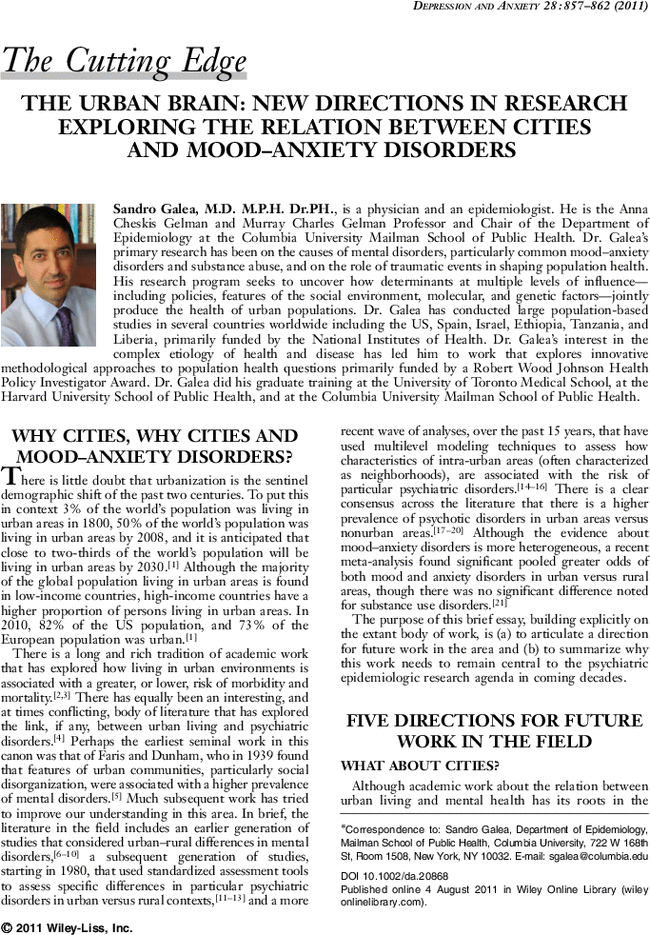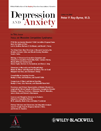The Cutting Edge
The urban brain: new directions in research exploring the relation between cities and mood–anxiety disorders
Sandro Galea M.D. M.P.H. Dr.P.H.,
Corresponding Author
Sandro Galea M.D. M.P.H. Dr.P.H.
Department of Epidemiology, Mailman School of Public Health, Columbia University, 722 W 168th St, Room 1508, New York, NY 10032
Department of Epidemiology, Mailman School of Public Health, Columbia University, 722 W 168th St, Room 1508, New York, NY 10032Search for more papers by this authorSandro Galea M.D. M.P.H. Dr.P.H.,
Corresponding Author
Sandro Galea M.D. M.P.H. Dr.P.H.
Department of Epidemiology, Mailman School of Public Health, Columbia University, 722 W 168th St, Room 1508, New York, NY 10032
Department of Epidemiology, Mailman School of Public Health, Columbia University, 722 W 168th St, Room 1508, New York, NY 10032Search for more papers by this author
REFERENCES
- 1 Secretariat PDotDoEaSAotUN. World Population Prospects: The 2008 Revision and World Urbanization Prospects: The 2009 Revision. 2010.
- 2Galea S, Freudenberg N, Vlahov D. Cities and population health. Soc Sci Med 2005; 60: 1017–1033.
- 3Galea S, Vlahov D. Urban health: evidence, challenges, and directions. Annu Rev Public Health 2005; 26: 341–365.
- 4McGrath J, Saha S, Welham J, et al. A systematic review of the incidence of schizophrenia: the distribution of rates and the influence of sex, urbanicity, migrant status and methodology. BMC Med 2004; 2: 13.
- 5Faris RE, Dunham HW. Mental Disorders in Urban Areas: An Ecological Study of Schizophrenia and Other Psychoses. Chicago/London: University of Chicago Press; 1939.
- 6Srole L. Urbanization and mental health: some reformulations. Am Sci 1972; 60: 576–583.
- 7Brunetti PM, Dacher M, Sequeira S. Prevalence of psychological impairment in city and country samples. Acta Psychiatr Scand 1978; 58: 369–378.
- 8Law SK. Urban-rural differences in student mental health: the Hong Kong scene. Aust N Z J Psychiatry 1978; 12: 277–281.
- 9Fitzgerald JL, Mulford HA. Rural vs urban problem drinker clients. Am J Drug Alcohol Abuse 1979; 6: 235–243.
- 10Fichter MM, Weyerer S, Wittchen HU, Dilling H. Psychotherapy services and the prevalence of mental disorders in urban and rural areas. Arch Psychiatr Nervenkr 1983; 233: 39–57.
- 11Chu CC, Klein HE, Lange MH. Symptomatology differentials between urban and rural schizophrenics. Int J Soc Psychiatry 1982; 28: 251–255.
- 12Blazer DG, Kessler RC, McGonagle KA, Swartz MS. The prevalence and distribution of major depression in a national community sample: the National Comorbidity Survey. Am J Psychiatry 1994; 151: 979–986.
- 13Crowell Jr BA, George LK, Blazer D, Landerman R. Psychosocial risk factors and urban/rural differences in the prevalence of major depression. Br J Psychiatry 1986; 149: 307–314.
- 14Driessen G, Gunther N, Van Os J. Shared social environment and psychiatric disorder: a multilevel analysis of individual and ecological effects. Soc Psychiatry Psychiatr Epidemiol 1998; 33: 606–612.
- 15Kalff A, Kroes M, Vles J, et al. Neighbourhood level and individual level SES effects on child problem behaviour: a multilevel analysis. J Epidemiol Community Health 2001; 55: 246–250.
- 16Weich S, Blanchard M, Prince M et al. Mental health and the built environment: cross-sectional survey of individual and contextual risk factors for depression. Br J Psychiatry 2002; 180: 428–433.
- 17Krabbendam L, van Os J. Schizophrenia and urbanicity: a major environmental influence—conditional on genetic risk. Schizophr Bull 2005; 31: 795–799.
- 18Allardyce J, Boydell J. Review: the wider social environment and schizophrenia. Schizophr Bull 2006; 32: 592–598.
- 19Peterson LE, Tsai AC, Petterson S, Litaker DG. Rural-urban comparison of contextual associations with self-reported mental health status. Health Place 2009; 15: 125–132.
- 20Zammit S, Lewis G, Rasbash J, et al. Individuals, schools, and neighborhood: a multilevel longitudinal study of variation in incidence of psychotic disorders. Arch Gen Psychiatry 2010; 67: 914–922.
- 21Peen J, Schoevers RA, Beekman AT, Dekker J. The current status of urban-rural differences in psychiatric disorders. Acta Psychiatr Scand 2010; 121: 84–93.
- 22Groenewegen PP, van den Berg AE, de Vries S, Verheij RA. Vitamin G: effects of green space on health, well-being, and social safety. BMC Public Health 2006; 6: 149.
- 23Guite HF, Clark C, Ackrill G. The impact of the physical and urban environment on mental well-being. Public Health 2006; 120: 1117–1126.
- 24Lee AC, Maheswaran R. The health benefits of urban green spaces: a review of the evidence. J Public Health (Oxf) 2011; 33: 212–222.
- 25Pedersen CB, Raaschou-Nielsen O, Hertel O, Mortensen PB. Air pollution from traffic and schizophrenia risk. Schizophr Res 2004; 66: 83–85.
- 26Ahern J, Galea S, Hubbard A, Syme SL. Neighborhood smoking norms modify the relation between collective efficacy and smoking behavior. Drug Alcohol Depend 2009; 100: 138–145.
- 27Ahern J, Galea S. Collective efficacy and major depression in urban neighborhoods. Am J Epidemiol 2011; 173: 1453–1462.
- 28Sampson RJ, Raudenbush SW, Earls F. Neighborhoods and violent crime: a multilevel study of collective efficacy. Science 1997; 277: 918–924.
- 29Christmas JJ. Psychological stresses of urban living: new direction for mental health services in the inner city. J Natl Med Assoc 1973; 65: 483–486 passim.
- 30Bachrach LL. The urban environment and mental health. Int J Soc Psychiatry 1992; 38: 5–15.
- 31Steele LS, Glazier RH, Lin E. Inequity in mental health care under Canadian universal health coverage. Psychiatr Serv 2006; 57: 317–324.
- 32Sutherland JE, Costa M. Epigenetics and the environment. Ann N Y Acad Sci 2003; 983: 151–160.
- 33Galea S, Ahern J, Rudenstine S, et al. Urban built environment and depression: a multilevel analysis. J Epidemiol Community Health 2005; 59: 822–827.
- 34van Os J, Krabbendam L, Myin-Germeys I, Delespaul P. The schizophrenia envirome. Curr Opin Psychiatry 2005; 18: 141–145.
- 35Galea S, Rudenstine S, Vlahov D. Drug use, misuse, and the urban environment. Drug Alcohol Rev 2005; 24: 127–136.
- 36Cerda M, Sagdeo A, Johnson J, Galea S. Genetic and environmental influences on psychiatric comorbidity: a systematic review. J Affect Disord 2010; 126: 14–38.
- 37Krueger RF, Caspi A, Moffitt TE, Silva PA. The structure and stability of common mental disorders (DSM-III-R): a longitudinal-epidemiological study. J Abnorm Psychol 1998; 107: 216–227.
- 38Fergusson DM, Horwood LJ. Predictive validity of categorically and dimensionally scored measures of disruptive childhood behaviors. J Am Acad Child Adolesc Psychiatry 1995; 34: 477–485; discussion 485–487.
- 39State MW. The erosion of phenotypic specificity in psychiatric genetics: emerging lessons from CNTNAP2. Biol Psychiatry 2011; 69: 816–817.
- 40Kelly BD, O'Callaghan E, Waddington JL, et al. Schizophrenia and the city: a review of literature and prospective study of psychosis and urbanicity in Ireland. Schizophr Res 2010; 116: 75–89.
- 41Dohrenwend BP, Dohrenwend BS. Social and cultural influences on psychopathology. Annu Rev Psychol 1974; 25: 417–452.
- 42Kasl SV, Harburg E. Mental health and the urban environment: some doubts and second thoughts. J Health Soc Behav 1975; 16: 268–282.
- 43McEwen BS. Mood disorders and allostatic load. Biol Psychiatry 2003; 54: 200–207.
- 44Capuron L, Miller AH. Immune system to brain signaling: neuropsychopharmacological implications. Pharmacol Ther 2011; 130: 226–238.
- 45Savignac HM, Hyland NP, Dinan TG, Cryan JF. The effects of repeated social interaction stress on behavioural and physiological parameters in a stress-sensitive mouse strain. Behav Brain Res 2011; 216: 576–584.
- 46Schiepers OJ, Wichers MC, Maes M. Cytokines and major depression. Prog Neuropsychopharmacol Biol Psychiatry 2005; 29: 201–217.
- 47Uddin M, Koenen KC, Aiello AE, et al. Epigenetic and inflammatory marker profiles associated with depression in a community-based epidemiologic sample. Psychol Med 2011; 41: 997–1007.
- 48Galea S, Uddin M, Koenen K. The urban environment and mental disorders: epigenetic links. Epigenetics 2011; 6: 400–404.
- 49Koenen KC, Aiello AE, Bakshis E, et al. Modification of the association between serotonin transporter genotype and risk of posttraumatic stress disorder in adults by county-level social environment. Am J Epidemiol 2009; 169: 704–711.
- 50Heijmans BT, Tobi EW, Stein AD, et al. Persistent epigenetic differences associated with prenatal exposure to famine in humans. Proc Natl Acad Sci USA 2008; 105: 17046–17049.
- 51Kim-Cohen J, Moffitt TE, Caspi A, Taylor A. Genetic and environmental processes in young children's resilience and vulnerability to socioeconomic deprivation. Child Dev 2004; 75: 651–668.
- 52Morris JD, Klahr NJ, Shen F, et al. Mapping a multidimensional emotion in response to television commercials. Hum Brain Mapp 2009; 30: 789–796.
- 53Samson AC, Meisenzahl E, Scheuerecker J, et al. Brain activation predicts treatment improvement in patients with major depressive disorder. J Psychiatr Res 2011. April 7 [Epub ahead of print]
- 54Frone MR. Does a permissive workplace substance use climate affect employees who do not use alcohol and drugs at work? A U.S. national study. Psychol Addict Behav 2009; 23: 386–390.
- 55Zhang X, Cowling DW, Tang H. The impact of social norm change strategies on smokers' quitting behaviours. Tob Control 2010; 19: i51–i55.
- 56Dohrenwend BP, Levav I, Shrout PE, et al. Socioeconomic status and psychiatric disorders: the causation-selection issue. Science 1992; 255: 946–952.
- 57Galea S, Riddle M, Kaplan GA. Causal thinking and complex system approaches in epidemiology. Int J Epidemiol 2010; 39: 97–106.
- 58Kaufman JS, Cooper RS. Seeking causal explanations in social epidemiology. Am J Epidemiol 1999; 150: 113–120.
- 59Kaufman JS, Kaufman S, Poole C. Causal inference from randomized trials in social epidemiology. Soc Sci Med 2003; 57: 2397–2409.
- 60Little RJ, Rubin DB. Causal effects in clinical and epidemiological studies via potential outcomes: concepts and analytical approaches. Annu Rev Public Health 2000; 21: 121–145.
- 61Oakes JM. The (mis)estimation of neighborhood effects: causal inference for a practicable social epidemiology. Soc Sci Med 2004; 58: 1929–1952.
- 62Hernan MA, VanderWeele TJ. Compound treatments and transportability of causal inference. Epidemiology 2011; 22: 368–377.
- 63Kaufman JS. Making causal inferences about macrosocial factors as a basis for public health policies. In: S Galea, editor. Macrosocial Determinants of Population Health. New York, NY: Springer; 2007: 355–374.
10.1007/978-0-387-70812-6_17 Google Scholar
- 64Leventhal T, Brooks-Gunn J. Moving to opportunity: an experimental study of neighborhood effects on mental health. Am J Public Health 2003; 93: 1576–1582.
- 65Rose G. Sick individuals and sick populations. Int J Epidemiol 1985; 14: 32–38.
- 66 Reduced Seconhand Smoke Exposure after Implementation of a comprehensive Statewide Smoking Ban—New York, June 26, 2003—June 30, 2004. Morbidity and Mortality Weekly Report (MMWR). Washington, DC: Center for Disease Control (CDC); 2007. p 705–708.
- 67Goodman PG, Haw S, Kabir Z, Clancy L. Are there health benefits associated with comprehensive smoke-free laws. Int J Public Health 2009; 54: 367–378.
- 68Butterworth P, Rodgers B, Windsor TD. Financial hardship, socio-economic position and depression: results from the PATH Through Life Survey. Soc Sci Med 2009; 69: 229–237.
- 69Lorant V, Deliege D, Eaton W, et al. Socioeconomic inequalities in depression: a meta-analysis. Am J Epidemiol 2003; 157: 98–112.
- 70Nickel JT, Brown KJ, Smith BA. Depression and anxiety among chronically ill heart patients: age differences in risk and predictors. Res Nurs Health 1990; 13: 87–97.
- 71Uutela A. Economic crisis and mental health. Curr Opin Psychiatry 2010; 23: 127–130.
- 72Weich S, Lewis G, Jenkins SP. Income inequality and the prevalence of common mental disorders in Britain. Br J Psychiatry 2001; 178: 222–227.
- 73Moffitt TE, Caspi A, Rutter M. Strategy for investigating interactions between measured genes and measured environments. Arch Gen Psychiatry 2005; 62: 473–481.




